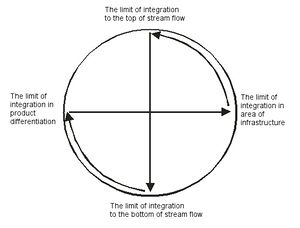Strategy wheel
| Strategy wheel |
|---|
| See also |
Strategy wheel is a tool that helps companies develop strategies, it takes into account the problem of determining the boundaries of organization, and allows the simultaneous inclusion of each of the selected types of boundaries. It should be noted that from the standpoint of cooperation in the supply chain, this tool allow not only the determination of limits on a scale of one cell in chain, but also support the determination of boundaries between units.
Use of the strategy wheel should be preceded by a preparatory phase, in which relevant information about company's products is gathered. Information about current developments concerning the supply, manufacturing and distribution is also gathered.
Shown in fig. 1. is a simplified schematic presentation of the scope of activities that should be taken in connection with formulating the strategy of the company acting in the supply chain, as far as determining the boundaries and limits of that organization. The main tasks in this analysis include:
- Create list of offered products.
- Identify market requirements (customer needs).
- Estimate the degree of satisfying of the market expectations by the existing offer.
- Define existing knowledge, competences, experience and infrastructure, in terms of ability to meet customer expectations.
- Determine the limit for supply chain upstream flows (the range of tasks in the supply of raw materials and intermediates, which should be implemented independently, and the range of tasks that should be done by the contractors).
- Determine the ability of the company to carry out tasks that occur after delivery of the raw materials, semi-finished or finished products.
- Define the limit for downstream flows.
- Select an optimal range of products that will be offered by the enterprise.
- Establish goals for development of the necessary skills, experience and infrastructure.
See also:
References
- Kotorov, R. P. (2001). The strategy wheel: a method for analysis and benchmarking for competitive strategy. Competitive Intelligence Review, 12(3), 21-30.
- Mintzberg, H. (1987). Crafting strategy (p. 66-75). Boston, MA: Harvard Business School Press.
- Mintzberg, H. (1994). The fall and rise of strategic planning. Harvard business review, 72(1), 107-114.
- Philpott E., Hamblin D. J., Baines T., Kay G., (2004), The use of models and methods of strategic planning: Towards a holistic view of strategy, International Transactions in Operational Research, vol. 11, International Federation of Operational Research Societes, Blackwell Publishing Ltd.
